Jurassic Coast
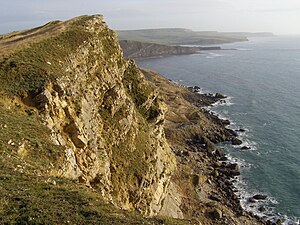
The Jurassic Coast is a stretch of coastline on the south coasts on Devon and Dorset, washed by the English Channel. This coast stretches from Orcombe Point near Exmouth in eastern Devon to the Old Harry Rocks near Swanage in eastern Dorset, a distance of 96 miles (155 km). The name "Jurassic Coast" refers to the wealth of dinosaur fossils found here from many ages. It was amongst these cliffs that Mary Anning and those who followed her found some of the earliest of the great dinosaurs and thus founded the modern science of palaeontology.
The entire length of the Jurassic Coast can be walked on the South West Coast Path.[1]
The Jurassic Coast has been declared a "World Heritage Site" by UNESCO, under the name "Dorset and East Devon Coast".[2] It was so designated in 2001 and was only the second wholly natural World Heritage Site to be designated in the United Kingdom.
Full of beauy and natural wonders, in a 2005 Radio Times readers' poll, the Jurassic Coast was named as the 5th greatest natural wonder in Britain.
Geology
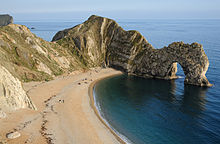
The Jurassic Coast consists of Triassic, Jurassic and Cretaceous cliffs, spanning the Mesozoic Era, documenting 180 million years of geological history.
This coast shows excellent examples of landforms, including the natural arch at Durdle Door, the cove and limestone folding at Lulworth Cove and an attached island, the Isle of Portland. Chesil Beach is a fine example of both a tombolo (a deposition landform in which an island is attached to the mainland by a narrow piece of land such as a spit or bar) and a storm beach (a beach affected by particularly fierce waves).
This coast has stretches of both concordant and discordant coastlines. Due to the quality of the varied geology, the site is the subject of international field studies.
Lyme Regis in the midst of this coastline, was home to Mary Anning, an amateur palaeontologist who studied the fossils of the coastline around Lyme Regis and discovered the first complete Ichthyosaur fossil at the Spittles.
The highest point on the Jurassic Coast, and on the entire south coast of Great Britain, is Golden Cap at 627 feet.
Features along the coast
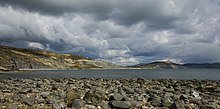
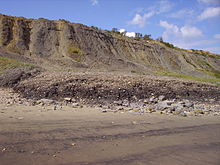
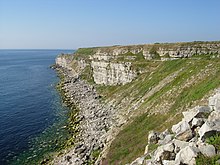
During Second World War several sections of the Jurassic Coast became property of the Ministry of War. One of the Royal Navy's largest bases was at Portland Harbour, though it has since closed. A major army base at Bovington remains in use today, and large areas of land, including the coast between Lulworth Cove and Kimmeridge, including Tyneham ghost village, are still only partially accessible.
Areas of the coast near Exmouth, The Fleet at Weymouth and the beaches at Studland have also been used for training for war, but have since been returned to civilian use.
Sea stacks, such as Old Harry's Rocks at Handfast Point, are an occasional feature of the coast.
Parts of the coast, especially around Portland, can be dangerous, and shipwrecks have been a feature of the coast. In January 2007 the coast experienced its most environmentally damaging wreck when the MSC Napoli, a container ship, was beached at Branscombe near Sidmouth, losing oil and cargo.[3]
Landslips and rockfalls are a continuing feature of the evolution of this coast. On 6 May 2008, a 430-yard section of the coast was dramatically re-shaped after a landslip that was described as the worst in 100 years.[4]
Towns
The towns along the coast are important local centres, and tend to be prosperous towns. For visitors they are ideal access points to the Jurassic Coast, and for those engaged in conservation and the management of the World Heritage Site there are facilities supporting their work. Each of the towns is a destination in its own right:
- Devon:
- Dorset:
Visitor centres
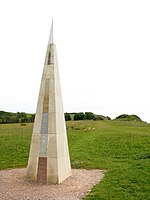
Various visitor centres and museums provide an additional concentration of information and interpretations on or of the Jurassic Coast, particularly from a local perspective.
At the eastern end, the Old Harry Rocks are a natural marker. At the western end at at Orcombe Point near Exmouth, the hand of man has placed a marker, the "Geoneedle" made from different rocks along the Jurassic Coast.
The following museums and heritage centres are recommended by the World Heritage Site Management:
- Beer Quarry Caves
- Charmouth Heritage Coast Centre
- Chesil Beach Centre
- Dorset County Museum, Dorchester
- Dorset Wildlife Trust Fine Foundation Marine Centre, Kimmeridge
- Durlston Country Park
- Fairlynch Museum, Budleigh Salterton
- Fine Foundation Centre, Beer
- Lulworth Cove Heritage Centre
- Philpot Museum, Lyme Regis
- Portland Bill Visitor Centre
- Portland Museum
- Sidmouth Museum
- Studland Visitor Centre, Knoll Beach
- Swanage Heritage Centre
Outside links
| ("Wikimedia Commons" has material about Jurassic Coast) |
- The Dorset Coast Forum
- National Geographic article on the Jurassic Coast
- BBC article on the Jurassic Coast
- The South West Coast Path National Trail
- Jurassic Coast official website
- Jurassic Coast, UNESCO World Heritage site datasheet
- Protected Planet Website
- UNEP-WCMC page on the Jurassic Coast
- South West Grid for Learning, Dorset Coast Forum, Countryside Agency and Dorset and Devon County Council joint Jurassic Coast site
- Geology of the Wessex Coast by Ian West, Southampton University
| World Heritage Sites in the United Kingdom |
|---|
|
Bath • Blaenavon Industrial Landscape • Blenheim Palace • Canterbury Cathedral, St Augustine's Abbey & St. Martin's Church • Castles and Town Walls of King Edward I • Cornwall and West Devon Mining Landscape • Derwent Valley Mills • Durham Castle & Cathedral • Edinburgh Old Town & New Town • Forth Bridge • Frontiers of the Roman Empire: Antonine Wall & Hadrian's Wall • Giant's Causeway • Ironbridge Gorge • Jurassic Coast • Kew Gardens • Liverpool Maritime Mercantile City • Maritime Greenwich • New Lanark • Heart of Neolithic Orkney • Pontcysyllte Aqueduct • St Kilda • Saltaire • Stonehenge, Avebury & Associated Sites • Studley Royal Park & Fountains Abbey • Tower of London • Palace of Westminster, Westminster Abbey & St Margaret's Church |
References
- ↑ "The Official Guide to the SWCP". SWCP Team. 2004. http://www.southwestcoastpath.com/. Retrieved 2007-01-14.
- ↑ "Dorset and East Devon Coast". UNESCO World Heritage Centre. 2001. http://whc.unesco.org/pg.cfm?cid=31&id_site=1029. Retrieved 2007-01-14.
- ↑ BBC News, 2007. Stricken cargo ship run aground.
- ↑ BBC News, 2008. Landslip is 'worst in 100 years'.
